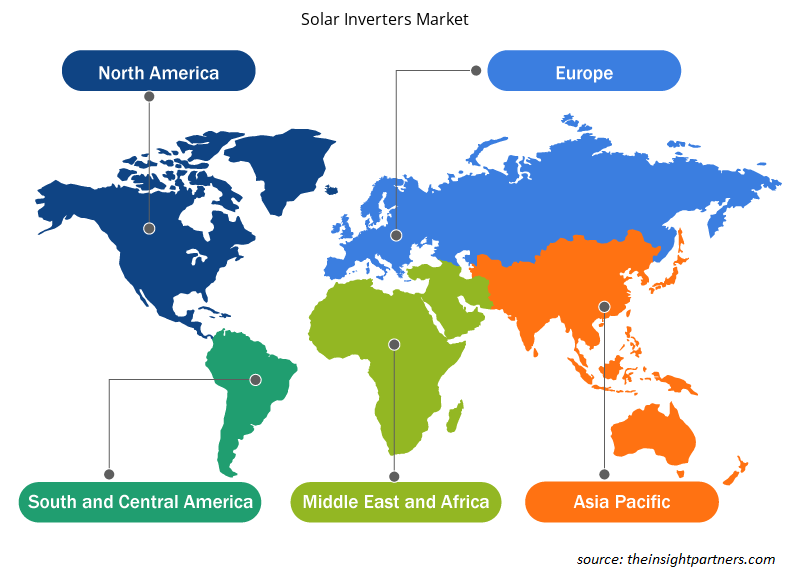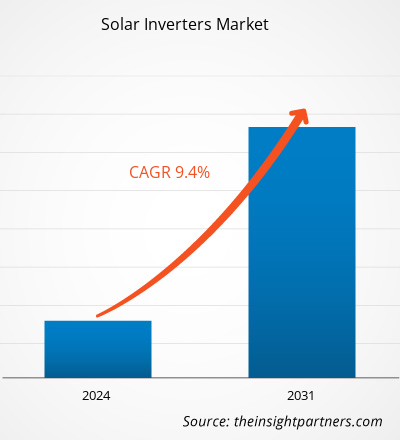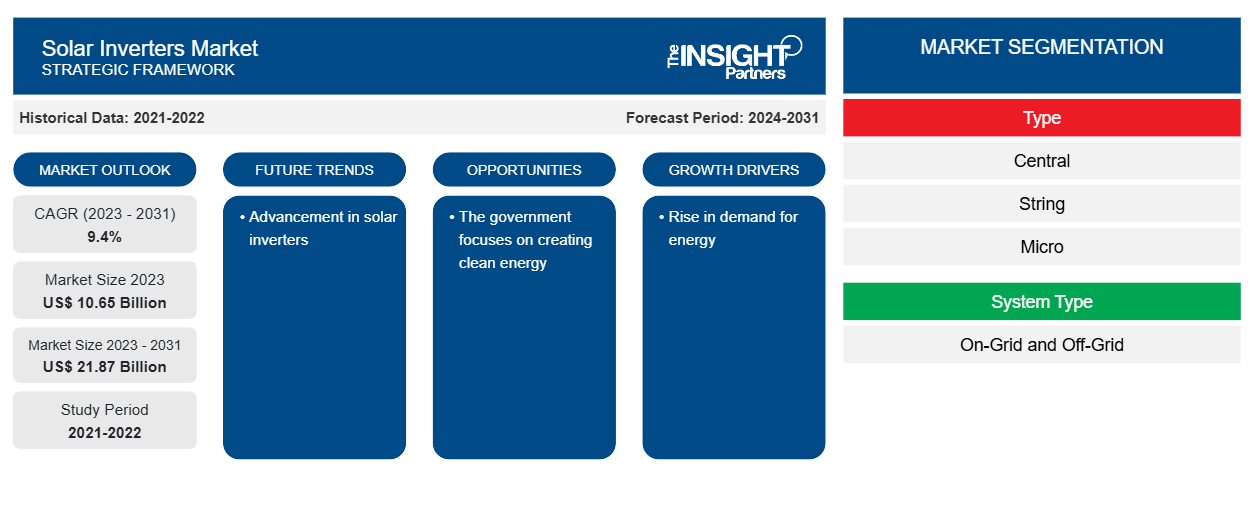Si prevede che la dimensione del mercato degli inverter solari raggiungerà i 21,87 miliardi di dollari entro il 2031, rispetto ai 10,65 miliardi di dollari del 2023. Si prevede che il mercato registrerà un CAGR del 9,4% nel periodo 2023-2031. La crescente necessità di soluzioni di energia pulita e l'aumento delle iniziative governative per installare inverter solari rimarranno probabilmente tendenze chiave nel mercato.CAGR of 9.4% during 2023–2031. The growing need for clean energy solutions and the rise in government initiatives to install solar inverters are likely to remain key trends in the market.
Analisi di mercato degli inverter solari
L'aumento degli investimenti nell'energia solare è uno dei principali fattori che alimentano il mercato degli inverter solari. Ad esempio, nell'aprile 2024, il Dipartimento degli Interni degli Stati Uniti ha annunciato un investimento di 19 milioni di dollari dal programma Investing in America del Presidente Biden per installare pannelli solari sui canali di irrigazione in California, Oregon e Utah, riducendo contemporaneamente l'evaporazione delle riserve idriche critiche e promuovendo gli obiettivi di energia pulita. Inoltre, la crescente installazione di tecnologia solare sui tetti nel settore residenziale sta guidando la crescita del mercato. Il governo che fornisce sussidi per l'installazione di tecnologia solare promuove ulteriormente la crescita del mercato degli inverter solari.fuelling the solar inverters market. For example, in April 2024, the US Department of the Interior announced a US$ 19 million investment from President Biden’s Investing in America agenda to install solar panels over irrigation canals in California, Oregon and Utah, simultaneously decreasing evaporation of critical water supplies and advancing clean energy goals. In addition, the growing installation of rooftop solar technology in the residential sector is driving the market growth. The government providing subsidies over the installation of solar technology further fosters the solar inverters market growth.
Panoramica del mercato degli inverter solari
Un inverter solare, noto anche come fotovoltaico
(
L'inverter PV) è un tipo di inverter di potenza che ricava energia dalla luce solare. Converte la corrente continua fotovoltaica variabile in corrente alternata che fornisce energia alla rete elettrica commerciale o viene utilizzata da una rete elettrica locale fuori dalla rete. La necessità di energia pulita sta crescendo in tutto il mondo per ridurre gli effetti negativi sull'ambiente. Questo fattore favorisce la domanda di energia solare, che alimenta ulteriormente il mercato degli inverter solari.
Personalizza questo report in base alle tue esigenze
Riceverai la personalizzazione gratuita di qualsiasi report, comprese parti di questo report, o analisi a livello nazionale, pacchetto dati Excel, oltre a usufruire di grandi offerte e sconti per start-up e università
-
Scopri le principali tendenze di mercato in questo rapporto.Questo campione GRATUITO includerà analisi di dati che spaziano dalle tendenze di mercato alle stime e alle previsioni.
Approfondimenti regionali sul mercato degli inverter solari
Le tendenze regionali e i fattori che influenzano il mercato degli inverter solari durante il periodo di previsione sono stati ampiamente spiegati dagli analisti di Insight Partners. Questa sezione discute anche i segmenti e la geografia del mercato degli inverter solari in Nord America, Europa, Asia Pacifico, Medio Oriente e Africa e America meridionale e centrale.

- Ottieni i dati specifici regionali per il mercato degli inverter solari
Ambito del rapporto di mercato degli inverter solari
| Attributo del report | Dettagli |
|---|---|
| Dimensioni del mercato nel 2023 | 10,65 miliardi di dollari USA |
| Dimensioni del mercato entro il 2031 | 21,87 miliardi di dollari USA |
| CAGR globale (2023-2031)CAGR (2023 - 2031) | 9,4% |
| Dati storici | 2021-2022 |
| Periodo di previsione | 2024-2031 |
| Segmenti coperti |
Per tipo
|
| Regioni e Paesi coperti |
America del Nord
|
| Leader di mercato e profili aziendali chiave |
|
Densità dei player del mercato degli inverter solari: comprendere il suo impatto sulle dinamiche aziendali
Il mercato degli inverter solari sta crescendo rapidamente, spinto dalla crescente domanda degli utenti finali dovuta a fattori quali l'evoluzione delle preferenze dei consumatori, i progressi tecnologici e una maggiore consapevolezza dei vantaggi del prodotto. Con l'aumento della domanda, le aziende stanno ampliando le loro offerte, innovando per soddisfare le esigenze dei consumatori e capitalizzando sulle tendenze emergenti, il che alimenta ulteriormente la crescita del mercato.
La densità degli operatori di mercato si riferisce alla distribuzione di aziende o società che operano in un particolare mercato o settore. Indica quanti concorrenti (operatori di mercato) sono presenti in un dato spazio di mercato in relazione alle sue dimensioni o al valore di mercato totale.
Le principali aziende che operano nel mercato degli inverter solari sono:
- FIMER SpA.
- Delta Electronics, Inc.
- Enertechup
- BUONANOTTE
- Elettronica di potenza SL
- Sistemi Micro Powerone Pvt. Ltd
Disclaimer : le aziende elencate sopra non sono classificate secondo un ordine particolare.

- Ottieni una panoramica dei principali attori del mercato degli inverter solari
Notizie di mercato e sviluppi recenti sugli inverter solari
Il mercato degli inverter solari viene valutato raccogliendo dati qualitativi e quantitativi dopo la ricerca primaria e secondaria, che include importanti pubblicazioni aziendali, dati associativi e database. Di seguito sono elencati alcuni degli sviluppi nel mercato degli inverter solari:
- INVTSolar ha lanciato con successo l'ultimo prodotto XG1-5kW-S inverter on-grid, al SolarQuarter State Business Meet 2023 tenutosi in India. INVTSolar ha vinto il premio "State Leadership Awards 2023- Gujarat" che ha dimostrato la sua profonda accumulazione tecnica, la forte forza di R&S e i risultati eccezionali: inverter solare on-grid monofase XG1-5KTL-S. (Fonte: NTT Ltd, comunicato stampa, dicembre 2023)
- Colt Data Centre Services (DCS), fornitore globale di soluzioni per data center hyperscale e large enterprise, ha annunciato il lancio del suo primo data center in India. Il data center di punta Navi Mumbai segna l'espansione strategica e l'impegno di Colt DCS nel supportare la crescente domanda di provider di servizi cloud hyperscale e grandi aziende nel mercato indiano dei data center in rapida crescita. Il data center vanta una sottostazione GIS da 220 kV altamente resiliente in loco con configurazione LILO. (Fonte: Colt Data Centre Services Holdings, comunicato stampa, settembre 2023)
Copertura e risultati del rapporto sul mercato degli inverter solari
Il rapporto "Dimensioni e previsioni del mercato degli inverter solari (2021-2031)" fornisce un'analisi dettagliata del mercato che copre le seguenti aree:
- dimensioni e previsioni del mercato degli inverter solari a livello globale, regionale e nazionale per tutti i segmenti di mercato chiave coperti dall'ambito
- tendenze del mercato degli inverter solari e dinamiche di mercato come driver, vincoli e opportunità chiave
- Analisi dettagliata delle cinque forze PEST/Porter e SWOT
- analisi di mercato degli inverter solari che copre le principali tendenze del mercato, il quadro globale e regionale, i principali attori, le normative e i recenti sviluppi del mercato
- Analisi del panorama industriale e della concorrenza che copre la concentrazione del mercato, l'analisi della mappa di calore, i principali attori e gli sviluppi recenti per il mercato degli inverter solari
- Profili aziendali dettagliati
- Analisi storica (2 anni), anno base, previsione (7 anni) con CAGR
- Analisi PEST e SWOT
- Valore/volume delle dimensioni del mercato - Globale, Regionale, Nazionale
- Industria e panorama competitivo
- Set di dati Excel
Report recenti
Rapporti correlati
Testimonianze
Motivo dell'acquisto
- Processo decisionale informato
- Comprensione delle dinamiche di mercato
- Analisi competitiva
- Analisi dei clienti
- Previsioni di mercato
- Mitigazione del rischio
- Pianificazione strategica
- Giustificazione degli investimenti
- Identificazione dei mercati emergenti
- Miglioramento delle strategie di marketing
- Aumento dell'efficienza operativa
- Allineamento alle tendenze normative























 Ottieni un campione gratuito per - Mercato degli inverter solari
Ottieni un campione gratuito per - Mercato degli inverter solari